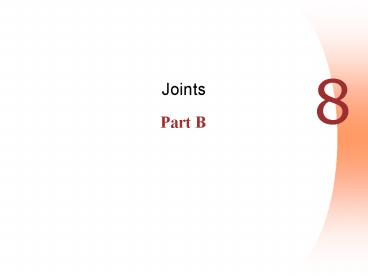Joints - PowerPoint PPT Presentation
1 / 17
Title:
Joints
Description:
Articular surfaces are essentially flat. Allow only slipping or gliding movements ... of the long head of biceps, which travels through the intertubercular groove ... – PowerPoint PPT presentation
Number of Views:64
Avg rating:3.0/5.0
Title: Joints
1
8
- Joints
- Part B
2
Types of Synovial Joints
- 1. Plane joints
- Articular surfaces are essentially flat
- Allow only slipping or gliding movements
- Only examples of nonaxial joints
Figure 8.7a
3
Types of Synovial Joints (continue)
- 2. Hinge joints
- Cylindrical projections of one bone fits into a
trough-shaped surface on another - Motion is along a single plane
- Uniaxial joints permit flexion and extension only
- Examples elbow and interphalangeal joints
4
Types of Synovial Joints
Figure 8.7b
5
3. Pivot Joints
- Rounded end of one bone protrudes into a
sleeve, or ring, composed of bone (and possibly
ligaments) of another - Only uniaxial movement allowed
- Examples joint between the axis and the dens,
and the proximal radioulnar joint
6
4. Condyloid, or Ellipsoidal, Joints
- Oval articular surface of one bone fits into a
complementary depression in another - Both articular surfaces are oval
- Biaxial joints permit all angular motions
- Examples radiocarpal (wrist) joints, and
metacarpophalangeal (knuckle) joints
7
5. Saddle Joints
- Similar to condyloid joints but allow greater
movement - Each articular surface has both a concave and a
convex surface - Example carpometacarpal joint of the thumb
8
6. Ball-and-Socket Joints
- A spherical or hemispherical head of one bone
articulates with a cuplike socket of another - Multiaxial joints permit the most freely moving
synovial joints - Examples shoulder and hip joints
9
Selected Synovial Joints Knee
- Largest and most complex joint of the body
- Allows flexion, extension, and some rotation
- Three joints in one surrounded by a single joint
cavity - Femoropatellar
- Lateral and medial tibiofemoral joints
10
Synovial Joints Knee Ligaments and Tendons
Anterior View
- Tendon of the quadriceps femoris muscle
- Lateral and medial patellar retinacula
- Fibular and tibial collateral ligaments
- Patellar ligament
Figure 8.8c
11
Synovial Joints Knee Other Supporting
Structures
- Anterior cruciate ligament
- Posterior cruciate ligament
- Medial meniscus (semilunar cartilage)
- Lateral meniscus
12
Synovial Joints Knee Other Supporting
Structures
Figure 8.8b
13
Synovial Joints Knee Posterior Superficial
View
- Adductor magnus tendon
- Articular capsule
- Oblique popliteal ligament
- Arcuate popliteal ligament
- Semimembranosus tendon
Figure 8.8e
14
Selected Synovial Joints Shoulder (Glenohumeral)
joint
- Ball-and-socket joint in which stability is
sacrificed to obtain greater freedom of movement - Head of humerus articulates with the glenoid
fossa of the scapula
15
Synovial Joints Shoulder Stability
- Weak stability is maintained by
- Thin, loose joint capsule
- Four ligaments coracohumeral, and three
glenohumeral - Tendon of the long head of biceps, which travels
through the intertubercular groove and secures
the humerus to the glenoid cavity - Rotator cuff (four tendons) that encircles the
shoulder joint and blends with the articular
capsule
16
Synovial Joints Shoulder Stability
Figure 8.10a
17
Synovial Joints Shoulder Stability
Figure 8.10b































